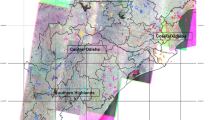Abstract
Bringing green revolution in eastern India (BGREI) is an initiative of Department of Agriculture and Co-operation (DAC) Ministry of Agriculture (MoA), Govt. of India with the aim of increasing crop productivity through improved inputs and package of practices in seven states of eastern India comprising the low productivity zones. The current study aimed at assessment of the BGREI plots with respect to crop vigour variability using space-based observations. Synthetic aperture radar (SAR) data were used to assess the rice crop growth pattern and vigour through change in backscatter response. A SAR-based methodology was developed to evaluate the effect of BGREI initiative in the state of Odisha. The peak biomass, an indicator of crop vigour was 15–30 % higher in BGREI plots compared to the controlled plots. The improvement was higher in traditionally low productivity rainfed zones. Uniformity in growth in terms of growth rate, transplantation time and duration was observed in BGREI plots. The positive effect of BGREI in Odisha indicates that BGREI may be a breakthrough in improving rice productivity in low productivity zones of eastern India .






Similar content being viewed by others
References
Aschbacher J, Pongsrihadulchai A, Karnchanasutham S, Rodprom C, Paudya DR, Le Toan T (1995) Assessment of ERS-1 SAR data for rice crop mapping and monitoring. IEEE T Geosci Remote GE-23:2183–2185
Chakraborty M (2002) Manual of procedures for rice crop monitoring using sar data, for ESCAP/SAC (ISRO) regional seminar and group training on capacity building for monitoring and assessment of rice crop in the ESCAP, ISRO/EOS/M/01/02, pp 47
Chakraborty M, Manjunath KR, Panigrahy S, Kundu N, Parihar JS (2005) Rice crop parameter retrieval using multi-temporal, multi-incidence angle Radarsat SAR data. ISPRS J Photogr 59:310–322
Foody GM, Curran P, Groom GB, Munro DC (1989) Multi-temporal airborne synthetic aperture radar data for crop classification. Geocarto Int 4:19–29
Haldar D, Chakraborty M, Jain V, Gopalan RS, Mukesh Khullar Parihar JS (2013) “BGREI paddy monitoring status in Orissa- comparative evaluation of 2011 and 2012”. SAC/EPSA/FASAL- R&D/ATDG/SR/01/2013
Haldar D, Das A, Yadav M, Hooda RS, Mohan S, Chakraborty M (2014) Analysis of temporal polarization phase difference for major crops in India. Prog Electromagn Res (PIER B) 57:299–309
Hoogeboom P (1983) Classification of agricultural crops in radar images. IEEE T Geosci Remote GE-23:329–336
Inoue Y, Sakaiya E (2013) Relationship between X-band backscattering coefficients from high resolution satellite SAR and biophysical variables in paddy rice. Remote Sens Lett 4(3):288–295
Kuenzer C, Knauer K (2013) Remote sensing of rice crop areas. Int J Remote Sens 34(6):2101–2139
Kuroso T, Suitz M, Fujita K, Chiba, Moriya T (1993) Rice crop monitoring with ERS-1 SAR—a first year result, Proceedings of 2nd ERS-1 symposium, Hamburg, Germany, 11–14 Oct 1993, ESA SP-361, (1):97–102
Le Toan T, Ribbes F, Floury N, Wang L, Kong JA, Kurosu T, Fujita M (1997) Rice crop mapping and monitoring using ERS-1 data based on experiment and modeling results. IEEE T Geosci Remote 35(1):41–56.
Socio- economy at Glance (2012) India at 2022, source-http://www.bgrei.nic.in
McNairn H, Decker V, Murnaghan K, (2002) The sensitivity of C-band polarimetric SAR to crop condition. IEEE international geoscience and remote sensing symposium 0-7803-7536-X, 1471–1473.s4
Panigrahy S, Chakraborty M, Sharma SA, Kundu N, Ghose SC, Pal M (1997) Early estimation of rice acreage using temporal ERS -1 synthetic aperture radar data—a case Study for Howrah and Hughly districts of West Bengal, India. Int J Remote Sens 18:1827–1833
Panigrahy S, Manjunath KR, Chakraborty M, Kundu N, Parihar JS (1999) Evaluation of RADARSAT standard beam data for identification of potato and rice crops in India. ISPRS J Photogr 54(4):254–262
Parihar JS, Panigrahy S, Chakraborty M (1997) ADRO document. Paddy rice monitoring with Radarsat 1. Available online
Premlatha M, Nageshwara Rao PP (1994) Crop acreage estimation using ERS-1 SAR data. J Indian Soc Remote Sens 22:139–147
Wang C, Wu J, Zhang Y, Pan G, Qi J, Salas WA (2009) Characterizing L-band scattering of paddy rice in southeast China with Radiative Transfer Model and multitemporal ALOS/PALSAR imagery. IEEE T Geosci Remote 47(4):988–998. doi:10.1109/TGRS.2008.2008309
Zhang Y, Wang C, Zhang Q (2011) Identifying paddy fields with dual-polarization ALOS/PALSAR data. Can J Remote Sens 37(1):103–111
Acknowledgments
The authors are grateful to Shri A.S. Kiran Kumar, Director SAC, for support and encouragement during the period of investigation. The authors are highly grateful to State Department of Agriculture, Orissa for providing ground data and BGREI point locations.
Author information
Authors and Affiliations
Corresponding author
Rights and permissions
About this article
Cite this article
Haldar, D., Manjunath, K.R., Panigrahy, S. et al. Monsoon paddy monitoring and assessment using synthetic aperture radar data under BGREI programme in Odisha, India. Paddy Water Environ 13, 343–352 (2015). https://doi.org/10.1007/s10333-014-0452-0
Received:
Revised:
Accepted:
Published:
Issue Date:
DOI: https://doi.org/10.1007/s10333-014-0452-0




